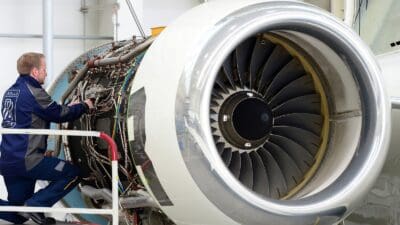For most shares in the FTSE 100, 2013 was a good year and investors have likely enjoyed capital gains and rising dividend income.
That makes me nervous about investing for 2014 and beyond, and I’m going to work hard to adhere to the first tenet of money management: preserve capital.
To help me avoid losses whilst pursuing gains, I’m examining companies from three important angles:
- Prospects;
- Risks;
- Valuation.
Today, I’m looking at aero engine and integrated power systems provider Rolls-Royce Holdings (LSE: RR) (NASDAQOTH: RYCEY.US).
Track record
With the shares at 1248p, Rolls-Royce Holdings’ market cap. is £23,466 million.
This table summarises the firm’s recent financial record:
| Year to December | 2008 | 2009 | 2010 | 2011 | 2012 |
|---|---|---|---|---|---|
| Revenue (£m) | 9,082 | 10,414 | 11,085 | 11,124 | 12,161 |
| Net cash from operations (£m) | 1,015 | 859 | 1,340 | 1,306 | 1,255 |
| Adjusted earnings per share | 36.7p | 39.67p | 38.73p | 48.54p | 59.27p |
| Dividend per share | 14.3p | 15p | 16p | 17.5p | 19.5p |
1) Prospects
Rolls-Royce’s particular variety of engineering excellence continues to deliver satisfying financial results according to the firm’s autumn management statement. For the full year, the directors expect what they describe as modest growth in underlying revenue and good growth in underlying profit, with cash flow around breakeven. We’ll be able to put figures on the outcome with the full-year results due on 13 February.
A steady stream of contract wins in the area of civil aviation throughout 2013 has been encouraging. Rolls-Royce’s Trent range of aero engines seems to have hit the sweet spot with aircraft designers, manufacturers and end customers. In the field of defence aerospace, the firm won multiple contracts worth over $600 million to provide and service military engines for various US government departments. There was also a cash realisation of 293 million Euros when the firm sold a 50% interest in a helicopter engine programme. In the firm’s marine and power systems activities, Rolls-Royce won the contract to design the propulsion system for the Royal Navy’s future Type 26 Global Combat Ship, which the firm reckons will feature the world’s most powerful marine gas turbine.
With the half-year results back in July, the order book was up around 15% at £69.2 billion compared to the year-ago figure. Progress seems to have continued since then and the firm’s rolling programme of research and development appears to be keeping the company at the top of its game and in the forefront of the minds of decision-makers with capital budgets in the industry. Indeed, last year’s R&D spend came in at around £919m.
As long as product innovation and development continues and service levels remain at the excellent end of the poor-to-outstanding continuum, Rolls-Royce seems well placed to deliver further steady growth in 2014 and beyond.
2) Risks
Rolls-Royce gains its ‘edge’ by delivering reliable and efficient products and services to the industries it serves by ensuring both high levels of continuing research and development and excellent service standards. To ensure that competitors don’t oust the firm from favour with its customers by offering something better or as good but cheaper, the firm must rigorously maintain such high standards. When a firm is achieving so highly, there is inevitably risk to the downside if the level of achievement falls. If standards start to slip, such risk could be realised.
Many of Rolls-Royce’s contracts are relatively large, so risk comes with having so much reliance on just a few major customers, such as individual airlines or sovereign governments. If one hitherto loyal major customer turns to a competitor, it could dent Rolls-Royce’s financial results.
There is clear political risk running alongside the firm’s defence markets. Should, for example, the US or UK government change its procurement policy, the trading landscape can change overnight. Likewise, there’s high vulnerability to regulatory control and potential manipulation here. In recent news, the Serious Fraud Office has announced an investigation into Rolls-Royces activities in overseas markets over concerns about possible bribery and corruption.
Finally, the firm’s activities are vulnerable to the cyclicality inherent in the macro-economic environment.
3) Valuation
Forward earnings cover the forward dividend around three times for 2015. That suggests the firm sees ongoing growth opportunities, as the resulting 2.1% forward dividend yield would be about 4.2% if earnings cover were halved to 1.5, say – the implication is that Rolls-Royce sees better uses for its cash than paying it all out as dividends, such as reinvesting for growth.
The forward P/E rating is running at about 16, which looks full compared to earnings growth expectations of 8% and that forward dividend yield.
What now?
Rolls-Royce Holdings enjoys attractive looking financial characteristics, and growth of around 8% a year looks likely. The firm’s P/E rating seems to reflect the quality of the enterprise, and as such is not an off-putting factor in itself.







